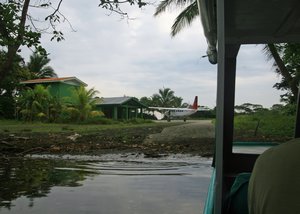Advertisement
Published: February 25th 2010

 Tortuguero Air Strip
Tortuguero Air Strip
It just seems so strange that just 6 minutes previously we'd finished breakfast and boarded our little boat before arriving at this airstrip by the side of the river!An early start. Up at 06h10, packed, bar bill paid and in breakfast by 06h50. Down by the dock for the short boat ride to the airstrip for our flight back to San Jose.
Whilst others were taking their bus on the long road trip, we'd arranged our own flight and, climbing out of the boat, we walked the short distance to the landing strip where our plane was waiting for us. Greeted by the pilots, they took our luggage and stowed it in the cubbyholes and invited us aboard. The ten of us filled the plane!
Sitting behind the pilot, I had a first hand taste of the pre-flight checks and the take-off. Whilst the co-pilot keyed the flight plan into the Garmin (yes …
Garmin!) the pilot was gaining permission to take-off from the control tower.
The little plane headed off down the strip and into the air, travelling at 110kts for most of the journey. At one point, the pilot turned to me and pointed out the first smoking volcano of the day - Mount Turrialba.
We landed back at San Jose International Airport and taxied to a halt in a private area. Whilst
walking towards the exit, we were asked to hurry as we were holding up another plane wishing to taxi out.
Grabbing our bags, we walked from the building directly into our waiting bus and out of the airport itself. It was such a strange experience to have this personal service and this unique experience - and it was only 08h20!
Smoking Volcano No 2 and 3 … and Coffee
Leaving San Jose, we headed north towards Poas, active volcano No 2. En route through fields of fern, coffee and flowers, we passed Irazu (active volcano No 3).
Climbing up towards the summit of Poas, we were in constant sunshine - hopeful that we'd actually not have a repeat of our visit to Irazu. Indeed, arriving at the summit, we were still in sunshine so, without having to wait, we walked the final few yards to be greeted by as view of the crater which can only be described as having the appearance of an open cast mine! The main difference, of course, is the smell of sulphur and the large plume of steam coming from the centre. The day before, there had been an eruption and
small quantities of ash were all over the place
Returning to the bus, we set of for a visit to a coffee plantation, where we'd have our own private tour and lunch. It transpires that, by law, all coffee in Costa Rica is Aribica and, the higher the altitude, the better the coffee.
We saw how the coffee is grown and from where the coffee bean actually comes. Moving inside, we were introduced to the first sorting room which consisted simply of a tank of water. The best (and ripest) beans sink to the bottom where they a syphoned away. The next best quality of bean are suspended in the centre of the tank where they too are syphoned. The poorest (or least ripe) beans float and they are skimmed off for processing. No surprise then that these poorest quality beans are used to make instant coffee.
Next, we saw how the coffee beans are peeled and prepared for export. Most beans for export are not roasted and can be kept to up to 12 months in storage in this way. Once peeled, the beans are steamed and then dried in the sun.
The strength of
the coffee comes from the roasting time, varying from 11 minutes (European) to 17 minutes (espresso) . All other coffees are simply different mixture of these two roasted beans. The only exception is decaffeinated coffee. This is extremely environmentally unfriendly to produce as the caffeine is extracted either using acetone or steam. All the liquid caffeine is used in the manufacture of Coke. In addition, there are only a handful of sites in the world which produce decaffeinated coffee meaning that it has to be transported vast distances to the UK.
Smoking Volcano No 4
After lunch, we had a very long ride to La Fortuna and our fourth volcano of the day. Checking into our rooms, we collected our cameras and returned to the bus for a trip to Arenal. This almost perfect dome produces plumes of smoke during the day, but pyrotechnic displays after dark. Within 5 minutes of arriving at the observatory, we were met with an eruption pouring molten lava and rocks down the flanks. Although the ground did not appear to move, the sound of boulders being hurled through the air and landing some 3 km from summit was rather eerie.
All
in all, a very long day but a fascinating one!
Advertisement
Tot: 0.203s; Tpl: 0.013s; cc: 19; qc: 89; dbt: 0.1386s; 1; m:domysql w:travelblog (10.17.0.13); sld: 1;
; mem: 1.3mb


















